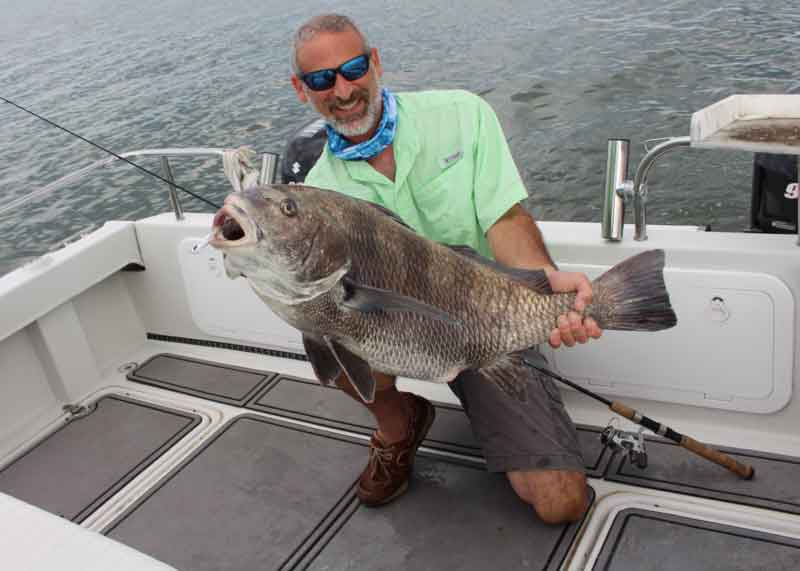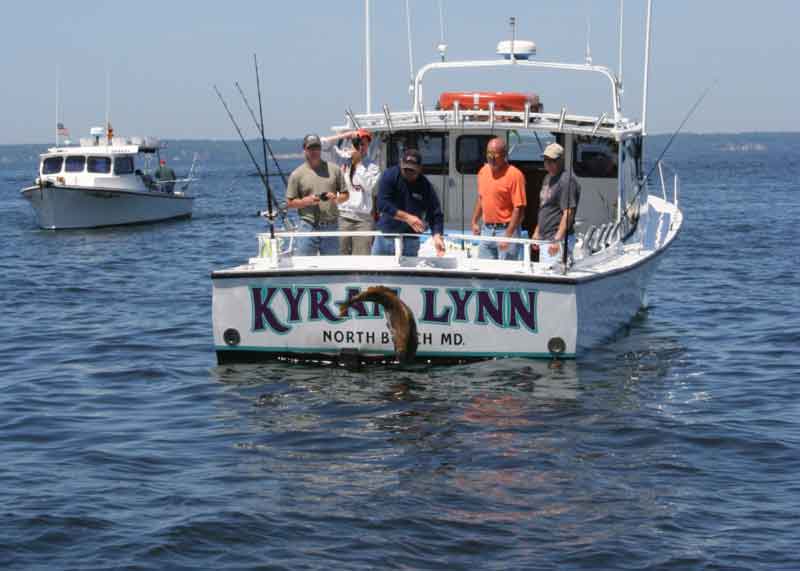Black drum, which derive their name from their black body and the drumming sound that they produce, are a popular target for Chesapeake Bay fishing for both beginners and experienced fishermen. This fish has been proven to live for nearly 60 years and in the Atlantic region, black drum can be found from the Delaware Bay to Florida. While the fish vary in age and location along the east coast, it has been found that southern anglers typically are after the younger and smaller black drum whereas in the northern regions they target the older and larger black drum.

Members of the Sciaenidae family, black drum are around 40 to 60 inches in length and many of the older fish found in the Chesapeake weigh between 50 to 100 pounds. Black drum are the largest member of the Sciaenidae family and have been caught with lengths up to 66 inches and a weight around 146 pounds. These fish are very fascinating, as they can locate prey in the bottom through their barbels underneath their chin. Then they use an extremely powerful jaw which allows them to eat shellfish.
The black drum spawn from April to the early days of June, along the eastern shore and the inlets of the Chesapeake Bay. During the spawning period, an adult black drum will lay around 30 million eggs. Like many other fish, young black drum are primarily concentrated in shallower portions of the water whereas mature adults are found in greater depths. When the young fish reach around two and a half inches they will migrate south with the adult black drum and will be found in greater depths.
Black Drum Identification
Black Drum can be identified by the following characteristics:
- Dark gray to black coloring of the body
- High arched back
- Barbels (whiskers) on the bottom jaw
- Cobblestone-like teeth
- Drumming sound
Black Drum Regulations
States throughout the region have different regulations in place to preserve black drum.
- Maryland holds a size regulation of 16 inches and a daily limit of one per person or six per boat. While there is both a size regulation and a limit on the amount to be caught, the season is open year-round.
- Virginia holds similar regulations to Maryland, as they require the drum to be 16 inches with a bag limit of one per person. Also like Maryland, the season is open year-round.
- Differing somewhat from Maryland and Virginia, Delaware has a size regulation of 16 inches and the season is open year round, yet the state allows for a bag limit of three per day.
State Records for Black Drum
In Maryland, Robert Messik Jr. holds the record for black drum with his 103.5 pound catch in September of 1973 near buoy 16. The state record for black drum in Virginia shatters Maryland’s as Betty Hall reeled in her record-setting 111 pound drum in 1973 off Cape Charles. Beating both Maryland and Virginia, Kenneth Smith of Frederica, Delaware caught a 115 pound fish in Delaware Bay in May of 1978 and holds that state’s record.
Best Black Drum Baits
Fishermen throughout the region have had the best luck catching black drum with:
- Crabs
- Clams
- Mussels
- Shrimp
- Cut fish
- Blood worms

Popular Techniques for Black Drum Fishing
Before setting out for black drum, make sure that you stop at the tackle shop on your way as live bait is an important part to catching a black drum. Black drum can be found in shallower waters in the cooler spring and fall months, making them a target for surf fishing. In the warmer months, the bigger black drum are found in greater depths near underwater structures, as they are bottom feeders and feed off aquatic life living around those structures. Here, most anglers target them with bait, although they are occasionally hooked by people trolling spoons or casting jigs. The specific techniques used for black drum vary widely depending on whether you’re targeting them near the coast, or up in the Middle Bay areas. Check out our article how to target black drum for more specific information on the techniques used in these different places.
Black Drum Fishing Tackle
Fishermen tend to use heavy conventional tackle rather than spinning tackle when targeting this species, as it’s easier to maneuver the fish away from structure like wrecks or bridge pilings to prevent possible damage to the line. A 30 to 50 pound rod with a fishfinder rig is a common set-up. The rig should be attached to a four to five foot fluorocarbon leader. When looking for the correct hook size, fishermen should go for the range of an 8/0 to 10/0 circle hook. It is important that you use enough weight to keep the bait sitting on the bottom, as black drum are primarily concentrated near bottom structures. Since large black drum are not considered good to eat and often have worms in the meat most are released, so using a circle hook to prevent deep-hooking and injuring the fish is also considered very important.

Best Places to Fish for Black Drum
The best places to fish for black drum vary according to the area that is being fished. Throughout coastal inlets and Delaware, fishermen often anchor around areas of mussel beds, cast out their bait, and simply wait for the fish to bite. In the lower areas of the Chesapeake, anglers often soak their baits around the area of the Chesapeake Bay Bridge tunnel and its islands, and around the shoals and channel edges from Cape Charles to Fisherman’s Island and surrounding areas. (more information on this area can be found in the article Lower Bay Black Drum. When located in the middle areas of the Chesapeake, fishermen more often drive through the waters slowly and waiting to locate fish on their fish finder in areas where there are mussel or beds, reef sites, and wrecks.
Whether going out on your next charter boating adventure or your own personal boat, seek out these fish, bring your freshest bait, and your sturdier rod — the tremendous fight they provide they will prove to be a worthwhile investment of your time and their huge size makes for some great fishing pics.
-By Devin Garner